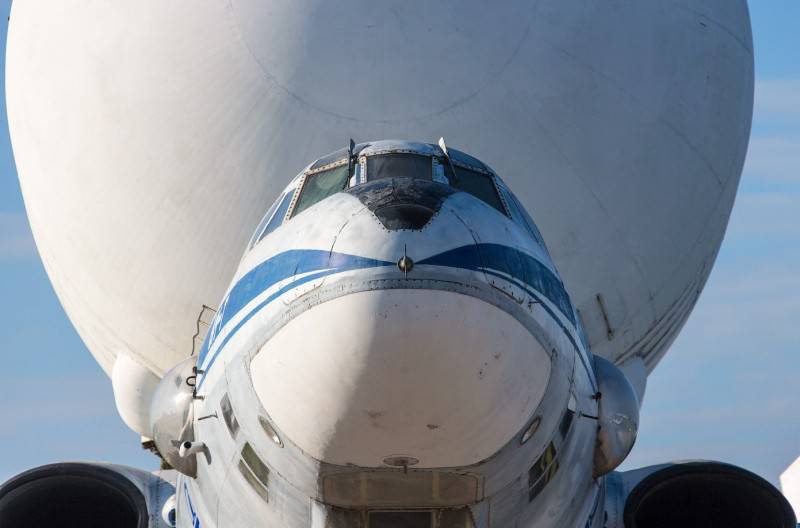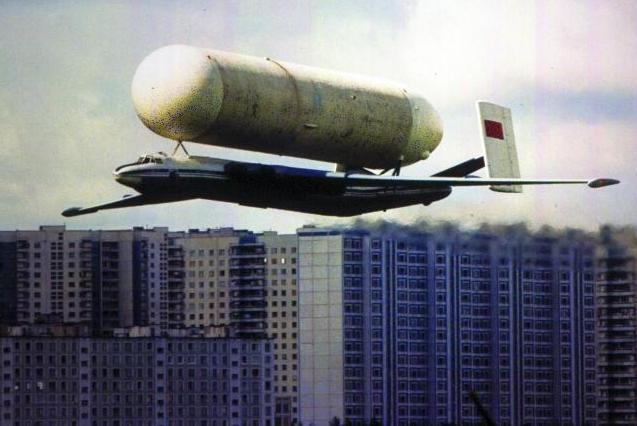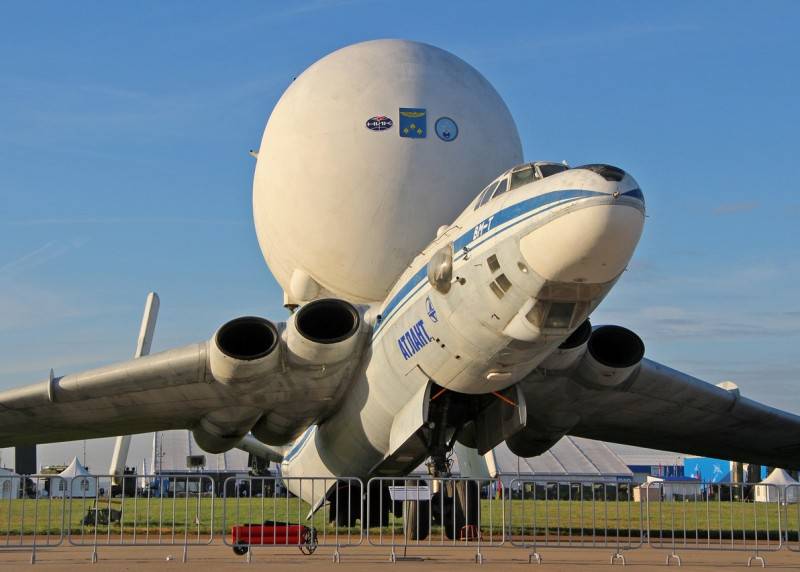What is known for the Atlas of Myasishchev?

A unique heavy transport aircraft, a "descendant" of the first Soviet strategic bomber 3M, and with a rounded body container on top of the fuselage, thanks to which it was called the "flying barrel", the VM-T Atlant was created at the beginning of 80-x to perform serious the tasks are to transport the orbiter “Buran” and the “Energy” launch vehicle from the manufacturing plants to the Baikonur cosmodrome.
How to create air titanium

In the development of the large-scale Soviet space program “Energy-Buran”, hundreds of enterprises of the country took part, which were scattered over a vast territory. All this created serious problems with the definition of the final place of assembly and delivery of parts and assemblies of the complex to the launch site - at Baikonur. At first, it was planned to concentrate all the main technological processes of assembly right near the cosmodrome, but this solution was quickly recognized as inexpedient, since it required the creation of a highly developed industrial infrastructure and the involvement of a huge number of skilled workers at Baikonur.
As a result, it was decided to conduct on-site assembly only and the entire prelaunch processing, while the bulk of the work was planned to be carried out at the head enterprises.
The most rational and tested way of transportation of goods of such large dimensions by rail was technically unacceptable, their size exceeded the size of railway platforms and did not fit into the railway passages under the bridges. Transportation by water along the Volga to the Volgograd region and the further construction of a single-track railway to Baikonur was too expensive.
The transportation of the space system (by separate modules) by air transport — by OKOV Antonov OK planes — seemed the most acceptable. But neither the intended modification of the Antey An-22 already in use, nor the use of the still-being-created An-124 Ruslan, did not solve the problem. Only the giant An-225 “Mriya”, designed at that time, could cope with the task. But the terms of its creation went far beyond the time limits of the Energy-Buran program. Moreover, the costly idea of building an assembly plant even at the cosmodrome began to be even seen. An appraisal attempt to use two helicopters (in conjunction) turned out to be technically impossible. The use of a new type of aircraft developed at the EMZ, the helicopter, seemed premature.
An unexpected and very low-cost idea was introduced by General Designer Vladimir Mikhailovich Myasischev, who proposed to modify who served in the combat units of the Far aviation 3M strategic bomber. The first flight of 3M took place on March 27, 1956 and has been in operation for more than 30 years, ensuring nuclear parity of the USSR and the USA, but this idea was also skeptical.
Myasishchev, relying on the preliminary studies of the OKB EMZ created by him and his experience, managed to convince the leadership of the Ministry of Aviation Industry (MAP) and the political leadership of the USSR in the viability and minimal cost of his idea.
21 November 1977 of the year issued the relevant Ordinance No. 1106-323 with very tight deadlines. In the process of improvements, it was necessary to ensure the safe flight of a modernized aircraft with four variants of the overall external load of different weights and different alignments, plus autonomous flight.
The novelty of design thought was in rather unusual proportions between the dimensions of the aircraft carrier and the cargo (the diameter of the tank compartments of the rocket was 8 meters, while the diameter of the fuselage of the aircraft was just 3 meters). The designers had to increase the length of the aircraft fuselage, make two-tail plumage and carry out a number of other improvements, including creating a unique system of pressurization of the launch vehicle units.
The correctness of the chosen concept was subsequently confirmed once again when designing the heaviest An-225 Mriya transport aircraft in the world, which could carry loads of up to 200 tons by air. The operating experience of the aircraft VM-T Atlant, and then the An-225 Mriya, confirmed the correctness of the concept of developing and operating complex layouts of aircraft, including various large-sized component parts, with significantly different mass, aerodynamic, and stiffness characteristics.
Less than a year later, 3 March 1978, General Designer V.M. Myasishchev and the head of the aerodynamics sector S.G. Smirnov brought to TsAGI elaborated posters (according to the rules of that time) of all five flight options of the future carrier. After the report and discussion, which was attended by the head of TsAGI, academician G.P. Svishchev, his deputy, academician G.S. Byuzhgens and Head of the 2 Laboratory (Aerodynamics) Dr.Sc. V.G. Mikeladze project was approved. This small meeting saved a lot of money for the country.
On the subject in OKB joked:
To transport this container
The old method was unusable.
Sat, thought, and here:
You two-story aircraft.
Although cheaper a hundred times
Big-big balloon.
It was possible to build the plane already to the apprentice of the aircraft designer Myasishchev - the chief designer V.A. Fedotov in the workshops of the same EMZ, but already the name of his eminent teacher. Additionally, even a system of in-flight refueling was created and tested on the stands.
Soon all (five) configurations of the plane rose to the sky:
29.04.1981 g. - standalone version
06.01.1982 g. - with hydrogen tank PH (D = 7,78 m, L = 44,46 m, G = 31,5 t). His name could be seen on MAX-2015.
21.12.1982 g. - with head and tail fairings ((D = 7,75 m, L = 15,67 m, G = 15,0 t)
01.03.1983 G. - with a glider VKS without keel (wingspan: 23,8 m, L = 38,45 m, G = 50,5t)
15.03.1983 g. - with blocks consisting of an oxygen tank, instrument and engine compartments and the head of the PH (D = 7,75 m, L = 26,41 m, G = 30,0 t)
In all flights, the crew was headed by the senior pilot of the Myasishchev team, honored test pilot A.P. Kucherenko.
Aerodynamics, stability and controllability studies have been conducted for each of the arrangements. For each variant of the cargo, its most advantageous placement on the fuselage in terms of length and height was determined. At the same time the minimum frontal resistance, obtaining the necessary alignments and many other necessary characteristics were provided. Studies of aerodynamic interference between aircraft and cargo were also conducted, revealing a pattern of distribution of local air loads on the fuselage surface and cargo. In fact, each version of the aircraft had its own control features. A large load placed on the "back" of Atlanta, strongly influenced its aerodynamics. Therefore, all flights took place in great tension. Yes, and criticism of this aircraft has always been a lot. Many thought that such a machine would simply not rise into the air. Others laughed: “airship plane”. Who are you lucky?
"Buran" on the "shoulders" of Atlanta

The Buran spacecraft were transported by VM-T aircraft to the Baikonur cosmodrome (Yubileiny airfield) from Ramenskoye airfield near Moscow, and the Energia launch vehicle units from the Beymbyanka Kuybyshevsky airfield. The units were loaded onto the aircraft using a special lifting and gantry device.
On two Atlants built in 1980, 200 flights were made on delivery of all large-sized elements of the Energiya and Buran space complexes to Baikonur, ensuring the successful space flight of the Buran 15 space station in November 1988. 1990 of the year under the Energy-Buran program was suspended, and 25 of May 1993 of the year was finally closed by the Decision of the Council of Chief Designers at Energia. At the same time, there are rumors that there was no official closing as such - allegedly, only the President of the Russian Federation can stop this program.
Passed the test "Mriya" drove "Buran" around the world, demonstrating its capabilities at air shows in Europe and America. The secrecy surrounding the space program has hidden the true hero of this transportation from the public. By the way, until now many people believe that it was Mriya that was carrying the Buran, but they didn’t even hear about VM-T.
Later in the OKB EMZ them. V.M. Myasishchev has developed projects for the use of the VM-T Atlant as a carrier of the platform for the air launch of the VCS: to launch the winged hypersonic accelerator; for throwing tests of various aerospace systems.
Currently, one of the copies of the VM-T can be seen at the airport of the 360-th Aviation Repair Plant in the village of Dyagilevo in Ryazan, another aircraft is located in the town of Zhukovsky on the territory of the VM Myasishchev EMR.
In 2013 and 2015, VM-T was shown to visitors at the static exposition of the Moscow International Aviation and Space Salon (MAKS).
Information